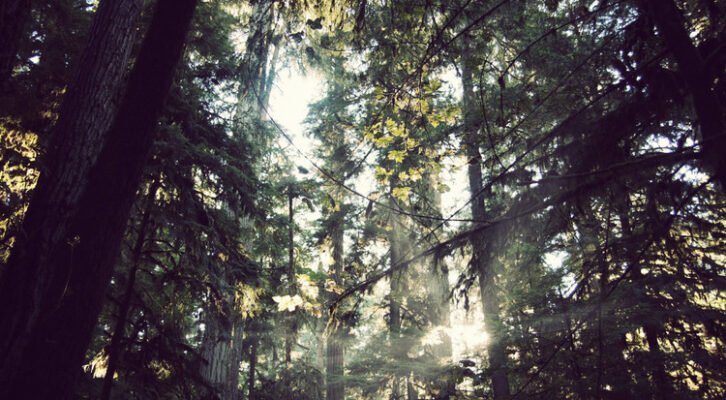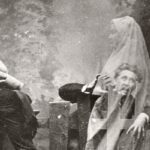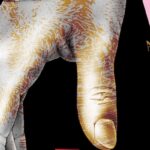
The Forest For the Trees: How “Backyard Biology” Can Lead to Scientific Breakthroughs
Thor Hanson on the Joys of Slowing Down and Discovering the Unknown In the Familiar
Though famed for his voyage around the world on HMS Beagle, with its auspicious stop in the Galapagos Islands, Charles Darwin was actually a notorious homebody. From the day he stepped back ashore at Falmouth in 1836 at the age of twenty-seven until his death nearly half a century later, Darwin never left Britain again.
Nearly all that time was spent at Down House, the comfortable country estate where he and his wife raised a large family, and where he pursued his studies through avid reading, extensive correspondence, and a seemingly endless variety of backyard experiments. He tracked bumblebees. He hand-pollinated foxgloves. He transplanted ants from one nest to another. He dunked ducks in duckweed to see if it would stick to their feathers. (It did.)
Darwin also bred pigeons, pears, and primroses, and he made midnight excursions to observe the behavior of earthworms. He germinated seeds extracted from pond muck, fish bellies, bird droppings, and the pellets coughed up by owls. He often searched the yard for bird nests and beetles, and he once tried feeding his own toenail clippings to a carnivorous sundew plant. (The sundew wasn’t interested.) As one of Darwin’s neighbors aptly put it, “Home was his experiment station, his laboratory, his workshop.”
If backyard observations helped Charles Darwin to better understand evolution, then they probably have a lot to teach all of us.
Many of the backyard investigations at Down House got their start during Darwin’s daily rambles along the “Sand-walk,” a quarter-mile (0.4-kilometer) trail that led from the back of the kitchen garden along a shady fence line that bordered his neighbor’s hayfield. Biographers have referred to it as Darwin’s “thinking path,” but he used the Sand-walk to watch nature just as much as he did to ponder it. Again and again, Darwin’s trailside observations fed directly into his work on larger themes.
When a weedy mustard sprouted from disturbed ground beside the path after a nine-year absence, he followed up with a series of trials and published “Vitality of Seeds,” an early paper on the concept of soil seed banks. Hand-pollinating a trailside patch of orchids inspired two years of research into the coevolution between insects and flowers, culminating in the book Fertilization of Orchids. The Sand-walk and surrounding meadows also provided ample testing grounds for Darwin’s long fascination with earthworms—their habits, their intelligence, and the vital role they play in moving soil up from the depths. He continued his walks and observations even as his health declined, and the backyard worm studies would be his last, published in book form just six months before his death in 1882.
It’s safe to say that Charles Darwin paid close attention to the plants and animals living in his yard. More than a pastime, that habit of constant scrutiny anchored his approach to science and provided boundless opportunities for testing and refining his ideas. It’s probably also safe to say that if backyard observations helped Charles Darwin to better understand evolution, then they probably have a lot to teach all of us. Of course, not everyone enjoys the benefits of living on a Victorian estate, with acres of grounds and gardens maintained by a full-time domestic staff. But as humble or grand as any individual version of a Sand-walk may be, all hold the promise of discovery. And as I continued along my own path, leaving the vireos behind and heading up the driveway to the road, it occurred to me that one feature of my yard might have filled old Darwin with envy: the trees.
Tall Douglas firs blanket much of the island where I live, part of the great temperate rainforest and related woodlands that hug the coastline of the Pacific Northwest from the northern tip of California to the Alaska panhandle. Darwin never glimpsed these cool, drippy landscapes—his route on the Beagle remained far to the south. But he ranked their austral counterpart, the “primeval forests” of Tierra del Fuego, as one of the most sublime sights he ever beheld. And he was certainly aware that woods of a similar scale thrived in northwestern North America. The Royal Horticultural Society, cofounded by one of Darwin’s uncles, had sponsored Scottish botanist David Douglas on a hugely successful plant-collecting trip to the region in 1824.
Douglas returned after three years with the seeds of more than 200 species, including those of his namesake fir and several other conifers capable of growing 10 feet (3 meters) or more in diameter and reaching heights of over 300 feet (91 meters). “A forest of these trees,” he wrote, “is a spectacle too much for one man to see.” Other explorers agreed. In one account from 1862, a strapping Royal Marine stationed near modern-day Vancouver, BC, wagered that he could fell a full-grown Douglas fir with an axe, and gave himself a week to finish the job. “But at the end of three days he found his hands blistered painfully, and the tree upright and almost uninjured as before.” The week expired with the fir still standing.
Trees of such magnitude were unheard of in rural England, and while Darwin surely enjoyed the copse of hazels, privets, and hornbeams he planted alongside the Sand-walk, there must have been times when he yearned for something larger and wilder. That thought helped me see our woods with fresh eyes—not just as a familiar backdrop, but as a rampant green force that towered over the driveway and the two-lane country road we live on, shrinking the sky to pale strips and sun shafts glimpsed through a geometry of branches, twigs, and needles. I walked in that fractal shade to a narrow footpath that descended from the road across the far side of our land, weaving through tree trunks and shoulder-high thickets of salal, an evergreen shrub related to heather and rhododendron.
Moss softened every footstep and draped the furrowed ridges of the fir boles where their bases flared to meet the ground. The hushed forest felt timeless, but for trees known to live a thousand years, these were still adolescents. The oldest among them dated to the late nineteenth century, part of the first generation to sprout after settlers and loggers cleared nearly all the region’s original forest, rather overzealously finishing the job begun by that axe-wielding marine. Still, the firs in our backyard had put their time to good use. Several already topped out at more than ten stories tall, with trunks 3 feet (0.9 meters) across—a vertical mass of life and habitat that I realized, as later forays in this book will show, I knew virtually nothing about.
New discoveries began piling up whenever I reminded myself not to just take the long route, but to take it slowly.
At a brisk pace, I can get from the road through our woods and out into the field below in less than four minutes. But I forced myself to slow down and concentrate on the details—the darker bark of the occasional lodgepole pine amongst the firs, or the spreading boughs of a young hemlock rooted in the remnants of a rotten stump. Splashes of red and pink announced the flowers of salmonberry and wild currant, and rough sword ferns brushed my legs, their long fronds arching from rosettes that crowded either side of the path. To a forestry professor I knew in graduate school, this scene would have qualified as “blah woods,” the common, expected species growing together in common and expected ways. That phrase always struck me as jaded, but in the context of backyard biology it’s downright dangerous. It not only devalues the beauty of everyday plants and animals, it blinds us to the many mysteries they still contain.
At the base of the slope, I crossed an old drainage ditch choked with slough sedge—a band of leafy green tufts that marked the water’s path like a thirsty hedgerow. Beyond the ditch, coniferous trees gave way suddenly to a brighter forest crowded with alders—dozens of pale, silvery trunks under a leafy canopy lush with springtime growth. There was a thicket of salmonberries, a few more trees, and then the trail emerged into an open pasture where Charles Darwin—or anyone else familiar with English meadows—might have felt right at home.
European settlers had brought their forage grasses with them, and our field contained several varieties known to occur at Down House, including tall fescue, wild rye, and sweet vernal grass, the first species that Darwin ever identified. “I have just made out my first Grass, hurrah! hurrah!” he exulted at the time. With the help of Catherine Thorley, his children’s governess and a skilled naturalist in her own right, Darwin went on to catalog 142 different grasses and wildflowers in Great Pucklands meadow, a 13-acre hayfield just over the fence from the Sand-walk. The number of species in our pasture was anyone’s guess—yet another glaring unknown along the path of my daily commute.
Skirting the edge of the field, I passed along the fence line of our garden and then across an overgrown, gravel-covered lot ripe for restoration. From there it was just a few more steps to the orchard, home to ten apple trees, three pears, two plums, a quince, and a peach, as well as eleven chickens and two noisy ducks. My office was there, tucked among the fruit trees, a simple, one-room structure we called the Raccoon Shack in honor of its former occupants. (With only one hollow tree on the property, anything with a roof or a crawlspace was valuable denning habitat.)
My journey from house to office had brought me through places so familiar I thought I knew them intimately. After all, I had been living on this land for more than twenty years. But even the slightest effort to “look at my fish” would quickly put that notion to rest. Just like finding vireos and raccoons living right alongside the driveway, new discoveries began piling up whenever I reminded myself not to just take the long route, but to take it slowly. I found a wild bitter cherry tree in full bloom, nestled among the firs, and I noticed a nuthatch chiseling out a nest hole in the top of a dead alder. I spotted species of ferns and orchids that I had overlooked right alongside the path, and I learned that if you listen long enough, a raven will sometimes inadvertently croak the cadence to “Shave and a Haircut…Two Bits.”
All these observations expanded my knowledge of the yard, but I realized that they all involved plants and animals I was already well acquainted with. In a sense, I was only seeing things that I already knew how to see. An adage paraphrased from French novelist Marcel Proust reads, “The real voyage of discovery consists not in seeking new landscapes, but in seeing with new eyes.” That’s excellent advice for any backyard biologist, and there are many ways to go about it. Perhaps the most straightforward, and a good place to start the next chapter, is to simply use someone else’s eyes.
__________________________________

Excerpted from Close to Home: The Wonders of Nature Just Outside Your Door by Thor Hanson. Copyright © 2025. Available from Basic Books, an imprint of Hachette Book Group, Inc.
Thor Hanson
Thor Hanson is a conservation biologist, Guggenheim fellow, and author of award-winning books including Hurricane Lizards and Plastic Squid, Buzz, Feathers, and The Triumph of Seeds. He lives with his wife and son on an island in Washington State.



















